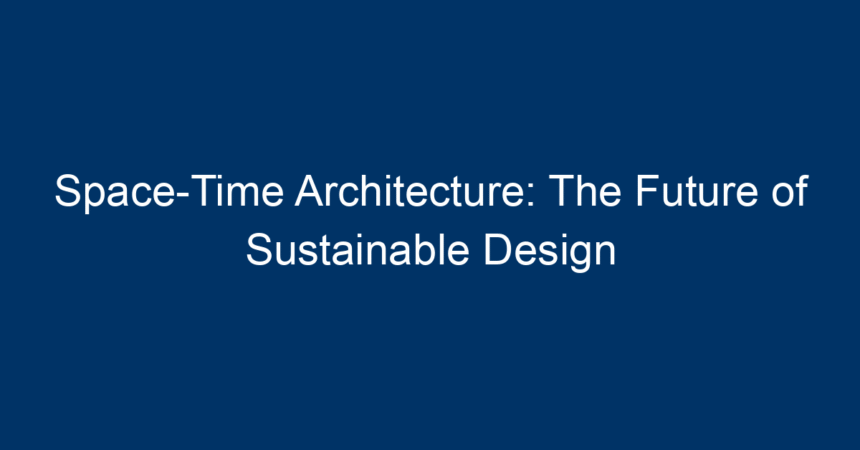In an era where environmental concerns and the quality of urban living are paramount, space-time architecture emerges as a transformative paradigm. This innovative approach combines spatial design with the perception of time, creating structures that evolve alongside human activities and environmental changes. As we delve into the principles and practices of space-time architecture, it becomes clear that this methodology not only addresses sustainability but also redefines how we interact with our living environments.
Understanding Space-Time Architecture
What is Space-Time Architecture?
Space-time architecture is a design philosophy that integrates the dimensions of space with the temporal aspects of human experience. Unlike traditional architecture, which often focuses on static structures, space-time architecture emphasizes adaptability and responsiveness to the surrounding environment. Through this lens, designs are created to evolve with changing climates, societal needs, and technological advancements, ultimately leading to sustainable living solutions.
The Historical Context of Sustainable Design
Sustainable design has its roots in the early environmental movements, but it has since transformed into a multifaceted approach that encompasses social, economic, and ecological dimensions. As architecture has evolved, so too has the understanding of what sustainability means. Historically, architects concentrated on using energy-efficient materials, passive solar designs, and renewable resources. However, as global challenges intensify, the need for a more holistic, integrative strategy like space-time architecture has become evident.
Key Principles of Space-Time Architecture
1. Adaptability
The cornerstone of space-time architecture is adaptability. Buildings designed with this principle can modify their uses or functions over time. A perfect example is the multi-purpose community center, which can serve as a gathering space, educational facility, or even a temporary shelter during natural disasters. This adaptability not only maximizes resource efficiency but also minimizes waste, aligning perfectly with sustainable principles.
2. Synchronicity with Nature
Space-time architecture emphasizes the synchronization of human activities with natural processes. This can be achieved through the integration of biophilic design, which fosters connections between people and nature. Utilizing natural light, ventilation, and landscaping can enhance the emotional well-being of occupants while promoting biodiversity in urban areas.
3. Technological Integration
In an increasingly digital world, the integration of technology in space-time architecture allows for real-time monitoring and adjustments. Smart building technologies can optimize energy usage, enhance structure resilience, and even predict maintenance needs. By blending architecture with cutting-edge technology, space-time architecture paves the way for innovative and sustainable living environments.
4. Community Engagement
Community involvement is vital in space-time architecture. By engaging local populations in the design and planning processes, architects can create spaces that resonate more deeply with the inhabitants. This participatory approach not only leads to more functional and beloved spaces but also fosters a sense of ownership and responsibility towards the environment.
The Role of Space-Time Architecture in Combatting Climate Change
Mitigating Urban Heat Islands
Urban areas often suffer from the “urban heat island” effect, where temperatures rise due to concrete, asphalt, and lack of vegetation. Space-time architecture aims to combat this through strategic landscaping and green roofs. These elements help cool the urban environment, reducing energy consumption associated with cooling systems while fostering ecological diversity.
Resource Efficiency
Efficient resource usage is another critical aspect of space-time architecture. By utilizing materials that are both sustainable and locally sourced, architects can significantly reduce the carbon footprint of new buildings. Additionally, implementing rainwater harvesting systems and renewable energy sources ensures that structures can operate sustainably.
Case Studies: Innovations in Space-Time Architecture
The Eden Project, UK
The Eden Project in Cornwall, UK, is a prime example of space-time architecture at work. This series of biomes, featuring various ecosystems, demonstrates how architecture can harmoniously integrate with nature. The design not only facilitates biodiversity but also engages visitors, encouraging environmental awareness and education.
Bosco Verticale, Milan
The Bosco Verticale (Vertical Forest) in Milan is another stunning illustration. These residential high-rises incorporate thousands of trees and plants into their design, significantly improving air quality while providing residents with immersive green spaces. By integrating nature into high-density urban living, Bosco Verticale exemplifies how space-time architecture reconfigures the relationship between people and their environments.
The Hive, Melbourne
The Hive in Melbourne showcases the symbiosis between nature and technology. Its innovative design allows the building to adapt to weather conditions, maximizing energy efficiency. The use of solar panels and green roofs reflects the commitment to sustainability and demonstrates how modern architecture can utilize technology to create environmentally friendly spaces.
The Future of Space-Time Architecture
Challenges and Opportunities
As with any evolving field, space-time architecture faces challenges, including regulatory hurdles, funding for innovative projects, and the need for widespread education on sustainable practices. However, these challenges also present opportunities for collaboration between architects, urban planners, and community leaders.
Continuous Learning and Innovation
For space-time architecture to thrive, it must embrace continuous learning and innovation. Collaborating with scientists, environmentalists, and technologists will drive the creation of designs that respond effectively to climate change. Furthermore, educating both professionals and the public about these practices will foster a culture of sustainability.
A Vision for Tomorrow
Imagine cities where buildings breathe with their inhabitants, adapting to seasonal changes, welcoming nature into their interiors, and promoting social interaction among residents. Space-time architecture provides a roadmap to this vision, highlighting the potential for creativity and sustainability in urban design. By considering not just the physical structure but also the temporal experience, we can create spaces that are not only functional but also enriching.
Conclusion
Space-time architecture encapsulates a forward-thinking approach to sustainable design, promising a future where buildings harmonize with their environments and communities. By integrating adaptability, synchronicity with nature, technology, and community engagement, we can redefine our living spaces to be resilient, efficient, and harmonious with the world around us. As we look towards tomorrow, embracing the principles of space-time architecture will be crucial in our quest for sustainability.
Actionable Insights
- Incorporate Feedback: Engage communities in the design process to ensure that buildings meet the needs of their users.
- Invest in Technology: Leverage smart building technologies that optimize resources and provide real-time feedback on energy usage.
- Use Sustainable Materials: Prioritize the use of locally sourced, sustainable materials in construction projects.
- Promote Adaptability: Design spaces that can serve multiple purposes and adapt to changing needs over time.
By adopting these strategies, architects and designers can lead the charge towards a more sustainable future through space-time architecture. The path may be challenging, but the rewards—healthy environments, resilient communities, and a harmonious relationship with nature—are well worth the effort.




